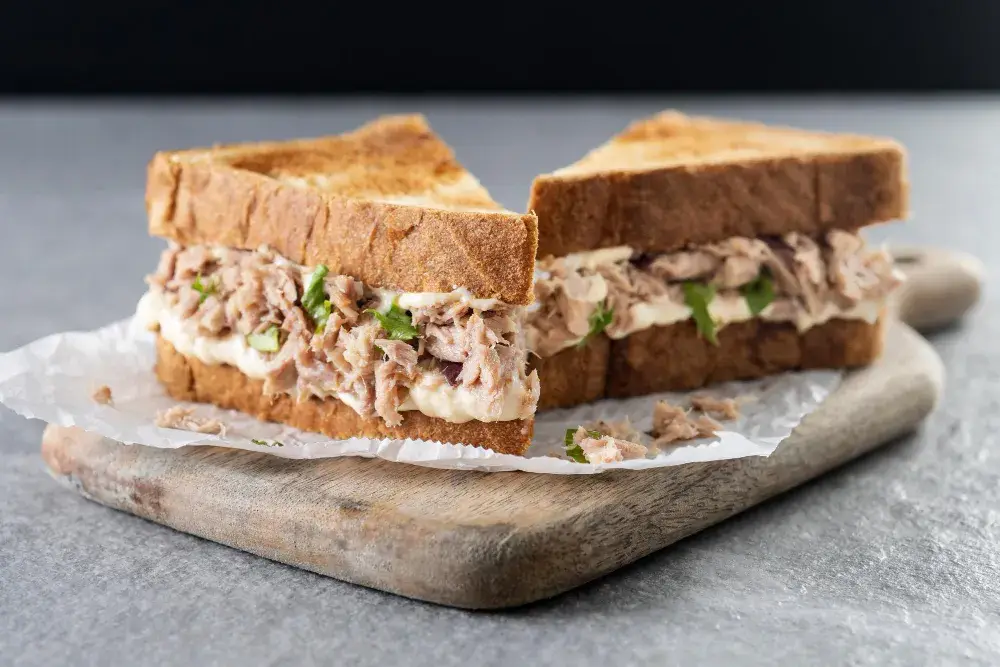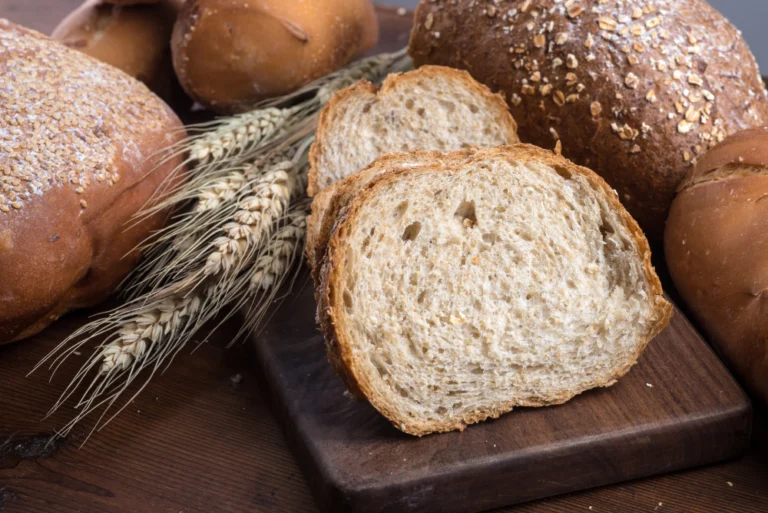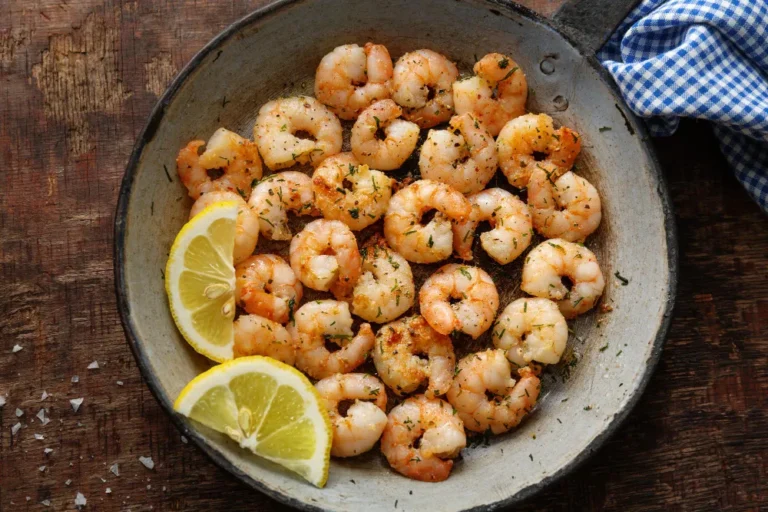Are you tired of the same old store-bought lunch options? Look no further! A homemade tuna sandwich is a quick, satisfying meal that’s superior to anything you can buy. With a few simple ingredients, you can create a recipe that suits your taste preferences.
A tuna salad sandwich is not just quick and easy for lunch or dinner it’s also wonderfully versatile. You can customize it with your favorite ingredients, from the type of bread you use to the additional veggies or condiments you add. In this guide, we’ll walk you through the process of selecting the best ingredients, preparing the perfect tuna filling, and assembling a sandwich that’s both delicious and visually appealing.
By following our step-by-step recipe, you’ll learn how to create a mouth-watering tuna sandwich that’s sure to become a staple in your meal rotation, all while avoiding soggy bread and ensuring a fresh tuna salad.
Listen to our podcast about this article
Table of Contents
The Perfect Tuna Sandwich Basics
The art of making a great tuna sandwich lies in understanding its basic components. To create a truly satisfying sandwich, you need to consider the quality of the ingredients and how they work together.
Why Homemade Tuna Sandwiches Are Better
Making tuna sandwiches at home gives you superior results compared to pre-packaged or food court options. When you make it yourself, you can control the quality of ingredients and freshness. Store-bought versions often have soggy bread and excessive mayonnaise.
Key Components of a Great Tuna Sandwich
A great tuna salad recipe includes quality tuna, fresh vegetables for crunch, the right bread, and a balanced dressing. The key to a satisfying sandwich is achieving a balance of flavors – tangy, creamy, and crunchy. Understanding these basics will help you create consistently delicious results with your recipe.
Essential Ingredients for a Classic Tuna Sandwich
The key to a delicious tuna sandwich is choosing the right tuna, mayonnaise, vegetables, and bread. Each component plays a crucial role in creating a balanced flavor and texture.
Choosing the Right Tuna
The liquid your tuna is packed in can make a big difference in its flavor. Tuna in olive oil generally provides a richer, more robust flavor compared to water-packed tuna. However, both options work well depending on your preference. If you prefer a milder taste, go with water-packed tuna. For a richer, bolder flavor, choose tuna packed in olive oil. You can use canned tuna for convenience and consistency.
Best Mayonnaise Options
The mayonnaise you choose can elevate your tuna sandwich. Whole-egg mayonnaise, such as Hellmann’s or Kewpie, offers a smoother, creamier flavor compared to regular mayonnaise. The richness of whole-egg mayo complements the tuna nicely, creating a more indulgent taste experience.
Fresh Vegetables and Herbs
Adding fresh vegetables and herbs introduces necessary texture and freshness to your tuna sandwich. Celery is a classic addition, providing a nice crunch. Herbs like dill, parsley, or basil add a fresh, aromatic flavor that enhances the overall taste. These ingredients work together to create a well-rounded flavor profile.
Bread Selection Tips
The bread you choose can make or break your tuna sandwich. From everyday sandwich bread to artisanal varieties, the options are vast. Think about the texture and flavor you want to achieve. Soft, white bread provides a neutral background, while whole grain or artisanal breads can add depth and complexity to your sandwich.
By combining high-quality tuna, the right mayonnaise, fresh vegetables and herbs, and a thoughtful bread choice, you can create a classic tuna sandwich that’s both flavorful and satisfying.
- 🐟 Canned Tuna (in olive oil or water – based on flavor preference)
- 🥚 Whole-Egg Mayonnaise (like Hellmann’s or Kewpie for creaminess)
- 🌿 Fresh Herbs (such as dill, parsley, or basil)
- 🥬 Celery (for a crisp crunch)
- 🍞 Bread (white, whole grain, or artisanal – your choice!)
How to Make Tuna Sandwich Filling
The foundation of a fantastic tuna sandwich is its salad, and we’re about to show you how to make it. Making a great tuna salad is about combining the right ingredients with the right technique.
Draining and Preparing the Tuna
To start, you need to properly drain the tuna. For oil-packed tuna, you may want to reserve some of the oil for added flavor later. For water-packed tuna, simply draining is sufficient. Use a fork to break up the tuna into smaller pieces, preparing it for mixing.
Mixing the Perfect Tuna Salad
Mixing is a crucial step. You want to be assertive with your mixing to break down the tuna into an almost paste-like consistency. Use a bowl and mix in your mayonnaise, ensuring it’s well combined with the tuna. Your target is to achieve a smooth, creamy texture.
Flavor Enhancers and Seasonings
To elevate your tuna salad, consider adding some pickle juice for a tangy flavor, a squeeze of lemon juice for freshness, and a spoonful of Dijon mustard for depth. Diced onion and fresh herbs bring a tasty crunch and burst of flavor. Finish it off with a sprinkle of black pepper to taste.
By following these steps, you’ll create a delicious tuna filling that’s both creamy and tangy, with a good balance of flavors. This will make your tuna sandwich truly stand out.
You may also like: Best Deer Meat BurgerStep-by-Step Sandwich Assembly

Now that you have your tuna filling ready, it’s time to bring your sandwich together. Assembling the sandwich is a crucial step that requires some finesse to ensure it holds together well and tastes great.
Preparing the Bread
Start by preparing your bread slices. You can choose to toast the bread for a crunchier texture or leave it plain. If you’re using butter, now is the time to apply a thin layer on one or both slices of bread to create a moisture barrier.
Adding Protective Layers
To prevent the bread from becoming soggy, add a layer of lettuce on one or both slices of bread. This acts as a protective barrier between the bread and the tuna filling.
Spreading the Filling
Spread your tuna filling evenly onto one slice of bread, making sure not to overfill it. The right amount of filling ensures that the sandwich is balanced and easy to bite into.
Final Assembly Tips
Once you’ve spread the tuna filling, place the other slice of bread on top to complete your sandwich. For make-ahead sandwiches, consider doubling up on the lettuce for extra protection against sogginess. Cut your sandwich carefully to maximize presentation and enjoyment.
Delicious Tuna Sandwich Variations
Elevate your tuna sandwich game with these delicious variations that offer a fresh twist on the classic recipe. You can transform your tuna sandwich into a new culinary experience by incorporating different ingredients and flavors.
Tuna Melt Recipe
For a tuna melt, add cheese – sharp cheddar works well – and grill until melted. This variation adds a rich, creamy element to the classic tuna salad. To make it, you’ll need to prepare your bread, add a layer of tuna salad, top it with cheese, and grill until the cheese is melted and bubbly.

Mediterranean Style Tuna Sandwich
The Mediterranean-style tuna sandwich includes ingredients like olives, capers, and fresh herbs such as dill and parsley. These additions bring a tangy, refreshing flavor profile to your tuna creation. Simply mix these ingredients into your tuna salad for an instant upgrade.
Spicy Tuna Sandwich Option
If you like a bit of heat, consider a spicy tuna melt variation. Incorporate hot sauce, jalapeños, or spicy mustard into your tuna salad for an added kick. This variation is perfect for those looking to add some excitement to their meal with a melt that’s both spicy and savory.
These variations demonstrate how you can build upon the classic tuna sandwich recipe to create distinct flavor profiles. Feel free to experiment with these ideas to discover your personal preferences and expand your tuna sandwich repertoire.
Healthy Substitutions and Alternatives

Healthy alternatives can elevate your tuna sandwich game without sacrificing flavor. By making a few simple substitutions, you can create a nutritious and delicious meal that meets your dietary needs.
Mayo-Free Options
You can replace mayonnaise with healthier alternatives like plain yogurt, whipped silken tofu, or a lemon vinaigrette to reduce fat and calories in your tuna salad. These options not only make your tuna sandwich healthier but also add a unique flavor profile.
Low-Carb Tuna Wraps
For a low-carb version of your tuna sandwich, consider using lettuce wraps or other vegetable-based wrappings instead of traditional bread. This substitution significantly reduces the carb content, making it suitable for low-carb diets.
Protein-Packed Variations
To boost the protein content of your tuna sandwich, add protein-rich ingredients like hard-boiled eggs, chickpeas, or nuts. These additions not only enhance the nutritional value but also complement the flavor of the tuna, creating a satisfying meal.
Storage and Make-Ahead Tips
You can make delicious tuna sandwiches in advance by following a few simple storage and preparation tips.
Duration of Tuna Filling
You can keep the tuna filling fresh in an airtight container in the fridge for 3 to 5 days. It’s crucial to check for signs of spoilage before consumption, such as off smells or slimy texture.
Preventing Soggy Bread
To keep your sandwiches fresh, use butter and lettuce as barrier layers between the bread and filling. This technique helps prevent the bread from becoming soggy.
Meal Preparation Strategies
For efficient meal prep, store the tuna filling, bread, and vegetables separately. Assemble the sandwich just before eating for optimal freshness. If you must prepare sandwiches ahead, store them in the refrigerator for a few minutes before serving.
You may also like: Make the Perfect Venison Burger at HomeConclusion
By following a few easy steps, you can create a mouth-watering tuna sandwich that’s sure to please. This guide has walked you through the essentials of making a great classic tuna salad, from choosing the right ingredients to assembling the perfect sandwich. With these simple recipes, you can enjoy a delicious meal in just a few minutes.
Experiment with different variations and ingredients to find your favorite tuna salad recipe. Whether you’re looking for a quick lunch or a satisfying dinner, a homemade tuna sandwich is a versatile and tasty option. Share your creations and tips to inspire others to get creative with their sandwiches!









